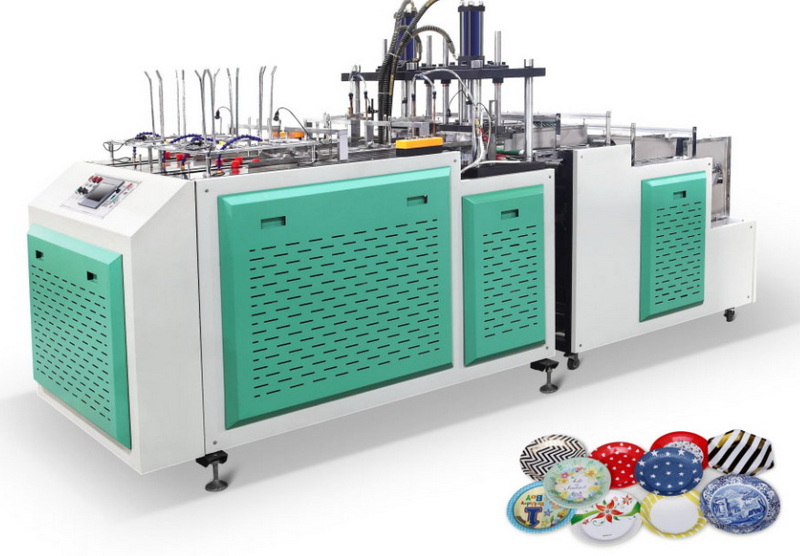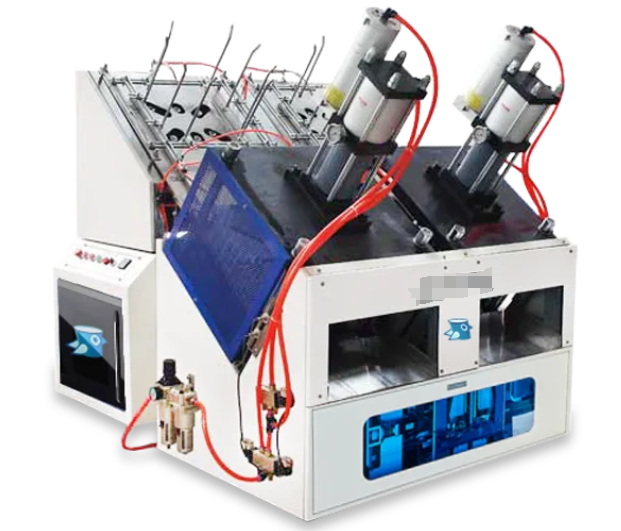
Content Menu
● Introduction to Disposable Paper Plate Making Machines
>> Key Components of a Disposable Paper Plate Making Machine
● Operation of a Disposable Paper Plate Making Machine
● Benefits of Using Disposable Paper Plate Making Machines
>> Market Trends and Growth
● Applications of Disposable Paper Plate Making Machines
● Environmental Impact of Disposable Paper Plates
● Technological Advancements and Future Directions
● Market Segmentation and Opportunities
● Role of Government Regulations
● Impact on Emerging Economies
● Technological Innovations in Production
● Market Competition and Leadership
● Consumer Awareness and Preference
● Future Outlook
● Additional Considerations for Sustainable Production
>> Role of Innovation in Sustainability
>> Impact of Circular Economy Practices
>> Global Market Dynamics
>> Supply Chain Optimization
>> Training and Support for Operators
● Conclusion
● Frequently Asked Questions
>> 1. What materials are used to make disposable paper plates?
>> 2. How efficient are disposable paper plate making machines?
>> 3. What are the environmental benefits of using disposable paper plates?
>> 4. Can disposable paper plates be customized?
>> 5. What industries commonly use disposable paper plate making machines?
Disposable paper plate making machines are innovative devices designed to produce disposable paper plates efficiently and sustainably. These machines are crucial in the food service industry, catering to the growing demand for eco-friendly tableware. In this article, we will delve into the operation, benefits, and applications of disposable paper plate making machines.

Introduction to Disposable Paper Plate Making Machines
Disposable paper plate making machines are automated systems that transform raw paper materials into finished plates. They are equipped with advanced technologies such as PLC control systems, mechanical paper feeding, and hydraulic systems to ensure precision and efficiency in production.
Key Components of a Disposable Paper Plate Making Machine
1. PLC Control System: This system ensures that all operations, from paper feeding to plate formation, are controlled and monitored efficiently. It allows for easy operation through a touch screen interface, making it user-friendly for operators.
2. Mechanical Paper Feeding: This mechanism is designed to feed paper into the machine smoothly and consistently, reducing waste and improving production stability.
3. Hydraulic System: Used for pressing and shaping the paper into the desired plate form. It is fast, energy-efficient, and environmentally friendly.
4. Heating and Forming: These functions are crucial for shaping the paper into the desired plate size and design. Vacuum suction and molds are often used to achieve precise shapes.
5. Automatic Counting and Transfer: Once the plates are formed, they are automatically counted and transferred to a packaging area for further processing.
Operation of a Disposable Paper Plate Making Machine
The operation of a disposable paper plate making machine involves several key steps:
1. Raw Material Preparation: The machine uses paper materials, typically with a weight range of 100-400 gsm, which may be coated with PE for durability.
2. Paper Feeding: The paper is fed into the machine using a mechanical system, ensuring consistent and smooth feeding.
3. Heating and Forming: The paper is heated and molded into the desired plate shape using molds and vacuum suction.
4. Pressing: The plate is pressed to ensure it retains its shape and is durable enough for use.
5. Automatic Counting and Packaging: The finished plates are counted and packaged for distribution.
To better understand the process, you can visualize the machine's operation as a seamless integration of mechanical and hydraulic systems working in harmony to produce high-quality plates efficiently.
Benefits of Using Disposable Paper Plate Making Machines
Disposable paper plate making machines offer several benefits:
1. Environmental Sustainability: They produce eco-friendly products by using biodegradable materials, reducing plastic waste.
2. High Production Efficiency: These machines can produce a large number of plates per minute, making them ideal for large-scale production.
3. Low Labor Costs: The automated process minimizes the need for manual labor, reducing production costs.
4. Customization Options: Plates can be customized with logos or designs, making them suitable for branding and marketing purposes.
5. Health and Safety Compliance: The machines ensure that the plates produced meet health and safety standards, making them safe for food service.
Market Trends and Growth
The market for disposable paper plate making machines is expected to witness significant growth due to increasing environmental awareness and stringent regulations against plastic use. Fully automatic hydraulic paper plate making machines are particularly in demand due to their high efficiency and productivity. These machines are equipped with advanced features such as programmable logic controllers (PLC) and touch screen interfaces, ensuring precise and consistent production.

Applications of Disposable Paper Plate Making Machines
Disposable paper plate making machines are widely used in various industries:
1. Food Service Industry: For catering services, fast food, and event management.
2. Packaging Industry: For food packaging and takeaway services.
3. Event Management: Ideal for parties, picnics, and other gatherings where disposable tableware is preferred.
The demand for disposable plates is also driven by the convenience they offer in food service and catering, reducing the need for washing dishes and saving labor costs.
Environmental Impact of Disposable Paper Plates
While disposable paper plates are considered eco-friendly alternatives to plastic, they also have environmental drawbacks:
1. Deforestation: Most paper plates are made from virgin wood pulp, contributing to deforestation and habitat loss.
2. Energy Consumption: The manufacturing process is energy-intensive, contributing to greenhouse gas emissions.
3. Recyclability Issues: Paper plates are often contaminated with food waste, making them difficult to recycle.
4. Chemical Pollution: The use of bleaching agents in production can lead to water pollution.
Despite these challenges, the shift towards sustainable materials and production methods is ongoing. Manufacturers are exploring the use of recycled paper and biodegradable coatings to mitigate environmental impacts.
Technological Advancements and Future Directions
Technological advancements in disposable paper plate making machines are focused on enhancing efficiency and sustainability. The integration of renewable energy sources in production processes is becoming more prevalent, reducing the carbon footprint of these machines. Additionally, advancements in automation allow for higher production volumes with minimal waste, making these machines more attractive for large-scale manufacturing.
The market is also witnessing a trend towards customization, with machines capable of producing plates in various shapes and sizes, including round, square, and customized shapes. This flexibility caters to diverse consumer preferences and branding needs.
Market Segmentation and Opportunities
The market for disposable paper plate making machines is segmented by machine type, plate size, and application. Fully automatic and semi-automatic machines are available, catering to different production needs. Plate sizes range from small to large, accommodating various uses from casual gatherings to large events.
Emerging economies present significant market opportunities due to growing consumer demand for sustainable products and increasing government regulations against plastic use. The shift towards eco-friendly alternatives is driven by consumer preference for sustainable products and government initiatives to reduce plastic waste.
Role of Government Regulations
Government regulations play a crucial role in driving the demand for sustainable disposable plates. Bans on single-use plastics in many regions have led to an increased focus on biodegradable alternatives like paper plates. These regulations not only influence consumer behavior but also encourage manufacturers to innovate and comply with environmental standards.
Impact on Emerging Economies
Emerging economies offer significant opportunities for the growth of the disposable paper plate making machine market. As these economies develop, there is a growing demand for sustainable products, driven by increasing consumer awareness and government initiatives. The adoption of renewable energy sources and sustainable materials in manufacturing processes can further enhance the appeal of these products in these markets.
Technological Innovations in Production
Technological innovations are key to improving the efficiency and sustainability of disposable paper plate production. Advances in automation and machine technology enable higher production volumes with reduced waste, making these machines more attractive for large-scale manufacturing. Additionally, the integration of renewable energy sources can reduce the carbon footprint of production processes, aligning with global efforts to reduce greenhouse gas emissions.
Market Competition and Leadership
The market for disposable paper plate making machines is competitive, with tier 1 companies leading in terms of production capacity and product diversity. These companies focus on producing high-quality products that meet regulatory standards, ensuring compliance with health and safety regulations, especially in food service applications.
Consumer Awareness and Preference
Consumer awareness about environmental issues is driving the demand for sustainable products. As consumers become more environmentally conscious, they prefer products that are biodegradable and compostable, leading to a shift towards paper plates and other eco-friendly alternatives. This trend is expected to continue, with manufacturers responding by developing more sustainable products and production methods.
Future Outlook
The future of disposable paper plate making machines looks promising, with ongoing technological advancements and growing demand for sustainable products. As the world moves towards a more circular economy, the role of these machines in reducing plastic waste and promoting eco-friendly tableware will become increasingly important.
Additional Considerations for Sustainable Production
In the quest for sustainability, manufacturers are exploring new materials and technologies to reduce the environmental footprint of disposable paper plates. This includes the use of recycled paper, biodegradable coatings, and renewable energy sources in production processes.
Role of Innovation in Sustainability
Innovation plays a critical role in enhancing the sustainability of disposable paper plates. By developing new materials and production methods, manufacturers can reduce the environmental impact of these products. For instance, using plant-based bioplastics or mushroom-based packaging materials can offer more sustainable alternatives to traditional paper plates.
Impact of Circular Economy Practices
The adoption of circular economy practices is crucial for reducing waste and promoting sustainability in the disposable paper plate industry. This involves designing products that are recyclable, reusable, or biodegradable, ensuring that resources are used efficiently throughout the product lifecycle.
Global Market Dynamics
The global market for disposable paper plate making machines is influenced by regional dynamics, including consumer preferences, regulatory environments, and economic conditions. Understanding these dynamics is essential for manufacturers seeking to expand their market presence and adapt to changing consumer needs.
Supply Chain Optimization
Optimizing the supply chain is vital for ensuring the efficiency and sustainability of disposable paper plate production. This involves sourcing raw materials responsibly, reducing transportation emissions, and implementing efficient distribution networks to minimize waste and costs.
Training and Support for Operators
Providing adequate training and support for machine operators is crucial for maximizing the efficiency and lifespan of disposable paper plate making machines. Proper operation and maintenance can significantly reduce downtime and improve product quality.
Conclusion
Disposable paper plate making machines are essential for producing eco-friendly and cost-effective disposable tableware. With their advanced automation and customization capabilities, these machines are ideal for businesses looking to expand their product offerings in the food service and packaging industries. As demand for sustainable products continues to rise, investing in a disposable paper plate making machine can be a strategic move for any business aiming to reduce environmental impact while increasing profitability.

Frequently Asked Questions
1. What materials are used to make disposable paper plates?
Disposable paper plates are typically made from paper with a weight range of 100-400 gsm, often coated with PE for durability.
2. How efficient are disposable paper plate making machines?
These machines can produce a significant number of plates per minute, with some models producing up to 85 plates per minute.
3. What are the environmental benefits of using disposable paper plates?
Disposable paper plates are biodegradable and reduce plastic waste, making them an environmentally friendly alternative to plastic or foam plates. However, they contribute to deforestation and have recyclability issues.
4. Can disposable paper plates be customized?
Yes, disposable paper plates can be customized with logos, designs, or branding, making them suitable for marketing and branding purposes.
5. What industries commonly use disposable paper plate making machines?
These machines are commonly used in the food service industry, packaging industry, and event management sector.

















